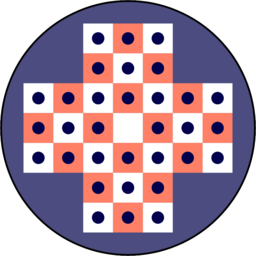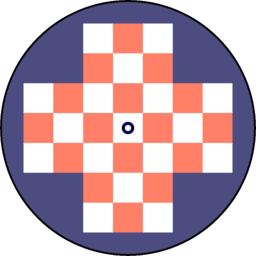Problems in Peg Solitaire
Peg Solitaire is played by jumping any peg on the board over an adjacent peg into an empty space, and removing the jumped peg. This collection has forty-seven puzzles which can all be played to a single peg remaining in the center of the board.

About the Problems
Some of the problems in this collection are drawn from the charming New Problems in Puzzle-Peg booklet (copyright 1929) included with the solitaire board I had as a child. Perhaps you had the same one, the one with the professorial owl on the box top. Mine lives in my office now. I modeled the graphics here on that version of the game. Of the remaining problems, some I drew up by hand, and some were computer-generated. The collection aims to be interesting, and well-graded in difficulty, rather than comprehensive. The difficulty ratings are subjective, so take them with a grain of salt.Further Resources
Peg Solitaire is rich in algebraic, combinatorial, and algorithmic theory. If you want to read more:- George's Peg Solitaire Page
- A Fresh Look at Peg Solitaire [PDF]
(George Bell) This article from Mathematics Magazine is a good place to start reading about the mathematical theory of the game.
- Designing peg solitaire puzzles
(George Bell) A 2016 paper on computer search for particularly challenging solitaire problems, as well as symmetric ones.
- Notes and papers on Peg Solitaire
(John Beasley) I recommend Beasley's out-of-print book The Ins and Outs of Peg Solitaire [Amazon], but if you can't find it, there is a generous amount of interesting reading on his web page, including more recent writings.
- Jaap's Puzzle Page: Peg Solitaire
(Jaap Scherphuis) - Jaap's page has a concise, memorable solution to the 32-peg "classic," or "central complement" puzzle, and some enumerative results. It is complemented by his more theoretical Analysis of Peg Solitaire page.
- One-Dimensional Peg Solitaire
(Cristopher Moore, David Eppstein) - From the abstract: We solve the problem of one-dimensional peg solitaire. In particular, we show that the set of configurations that can be reduced to a single peg forms a regular language, and that a linear-time algorithm exists for reducing any configuration to the minimum number of pegs.
George Bell's collection of information about peg solitaire is the ne plus ultra, and his list of references is so extensive that this one is practically redundant. However, it is so comprehensive that it can be overwhelming. You might want to start with one of the following articles instead.